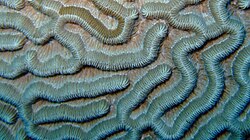Scleractinia
Scleractinia, also called stony corals or hard corals, an order in the Cnidaria. It contains the polyps which build most coral reefs.
| Stony corals | |
|---|---|

| |
| Scleractinian corals, illustration by Ernst Haeckel, 1904 | |
| Scientific classification | |
| Unrecognized taxon (fix): | Scleractinia |
| Families | |
|
About 35, see text. | |
| Synonyms | |
| |
Most of these corals are colonial. They secrete calcium carbonate, the base of every reef. Very often, the corals form a symbiosis with unicellular dinoflagellates. These zooxanthellae are usually of the genus Symbiodinium.
The closest relatives to stony corals are the sea anemones. Stony corals are only distantly related to fire corals and soft corals. There are about 1500 species, in 35 families.
Scleractinia Media
Montastraea annularis can be fragmented to form new colonies.
Palaeozoic rugose corals with calcite skeletons, like this Grewingkia canadensis, are doubtfully ancestors of the Scleractinia.
Scleractinian coral from the Matmor Formation (Jurassic) of Makhtesh Gadol
References
- ↑ Hoeksema, Bert (2015). "Scleractinia Bourne, 1900". WoRMS. World Register of Marine Species. Retrieved 2015-05-03.
+{{{1}}}−{{{2}}}







